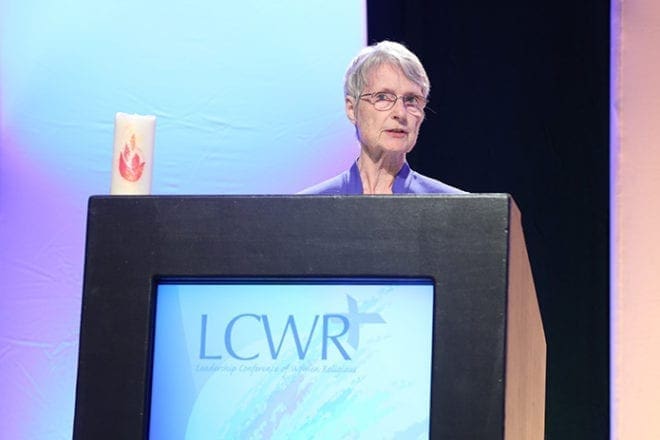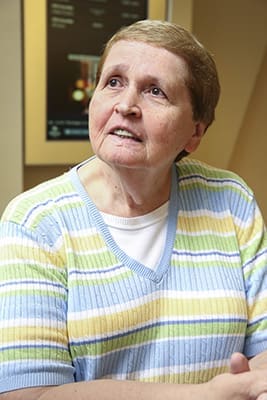(L-r) Sisters of St. Joseph Mary Pellegrino, president-elect of the Leadership Conference of Women Religious, of Baden, Pa., School Sisters of Notre Dame Catherine Bertrand of St. Paul, Minn., Sisters of St. Joseph of Chestnut Hill Liz Sweeney of Wilmington, Del., and Sisters of St. Francis Pat Farrell of Dubuque, Iowa, share ideas regarding what a conference for a post-contemporary generation of women religious would look like. Photo By Michael Alexander
Atlanta
Women religious at assembly urged to face crisis with contemplation
By ANDREW NELSON, Staff writer | Published August 18, 2016
ATLANTA—Some 800 members of the Leadership Conference of Women Religious gathered in Atlanta for their annual assembly Aug. 9-12. With the theme of “Embracing the Mystery: Living Transformation,” the sisters considered where God is moving in today’s world as they face smaller and graying communities.
“The whole assembly is about listening to the movements of God, not only individually, but collectively,” said Sister Annmarie Sanders, of the Sisters, Servants of the Immaculate Heart of Mary, the LCWR communications director.
In her presidential address, Sister Marcia Allen, of the Sisters of St. Joseph of Concordia, Kansas, called for “a new way of exercising hope” to envision a conference as the number of women religious serving the church continues to dwindle. The LCWR has approximately 1,350 members who are elected leaders of their religious orders, representing about 80 percent of the Catholic sisters in the United States.
A drop in numbers of religious
In an unsparing report to the organization’s members, she shared numbers about the drop in women and men who serve the church in religious congregations.
“In the belief that something will come of the ravages of collapse, hope is forged,” Sister Marcia said.

Leadership Conference of Women Religious president Sister Marcia Allen delivers her presidential address to the membership body Aug. 10. Sister Marcia, who resides in Concordia, Kansas, is president of her order, the Sisters of St. Joseph. Photo by Michael Alexander
“We are keeping a brave face on it, but the truth is that the very thing that makes the conference possible is disappearing,” said the president of the LCWR.
In 1995, there were 107,000 members of religious congregations, according to the National Religious Retirement Office, which requests statistics from men’s and women’s congregations each year. Twenty years later, in 2015, there were 49,000 members, according to the NRRO, with the majority being 70 or older. By 2025, the number is projected to be around 29,000, again with a majority at least 70 years of age.
While some congregations don’t take part in the survey, Sister Marcia said the statistics show the LCWR membership in nine years will not be larger, nor will most individual member congregations.
“Transformation is required. Remember, it is the new normal. We experience it all around us. We cannot escape it or pretend here in the conference that it is someone else’s problem,” she said.
This isn’t the first time women religious have reconsidered how they live their vowed lives, according to Sister Marcia. She described the movement of sisters across the Plains to the American West in the 19th century during which the sisters replaced the ways of living religious life that had developed in the East.
“The charisms hold, but we are challenged to something new,” she said. “Traditions were reinvented. Charism survived, purpose survived, but all the customs and homey expectations of the East were left behind.”
“In the face of necessity to survive and to serve in some meaningful way, a new life was, in fact, invented,” she said. “Many of us are the results of these reinventions.”
The ministries are vital in today’s world, she reminded the leaders of congregations from across the country. By painting the scene with several vignettes, she led the group in the sprawling ballroom “through an exercise of hope that expresses our faith.”
“Everything we have known about ourselves is but history at this point. It will turn out to be a hollow shell, a pyrrhic victory, unless we enter into the challenge before us,” she said.
She then led listeners in an exercise, encouraging them to consider the “horizon of expectation” to envision what a smaller Leadership Conference of Women Religious would look like and how it would serve the members.
“This is the same thing that must be done at home in local communities,” she said.
Looking to the horizon, aware of the current situation, she said, “I call this putting faith into the practice of hope.”
New perspectives, difficult decisions
Listeners in the audience walked away with new perspectives but said many of the congregations have wrestled with this issue for a while.

Grey Nun of the Sacred Heart Sister Dawn Gear attends the Leadership Conference of Women Religious assembly in Atlanta. Sister Dawn spent 26 years in the Archdiocese of Atlanta teaching and administering Catholic schools, but today she resides in Philadelphia. Photo By Michael Alexander
Sister Dawn Gear, on the Leadership Council of her congregation, the Grey Nuns of the Sacred Heart, said the message delivered to the leaders in Atlanta isn’t new, but it reinforces how congregations need to be aware of the situation and perhaps make hard decisions. Sister Dawn said the Grey Nuns recently sold their motherhouse outside Philadelphia to secure money to pay for care of aging sisters.
“It’s like a family. We need to think about these things,” said Sister Dawn, who was the founding principal of three Catholic schools in the Atlanta Archdiocese. “We didn’t start this yesterday. But it’s here.”
Sister Miriam Harney, a member of the Sisters of the Holy Faith, works in Los Angeles as a grief counselor. She appreciated the viewpoint of making decisions after community contemplation and listening to others’ wisdom. Decisions are reinforced by faith when religious communities “look out into the horizon and see what’s on the periphery,” she said, and are not just focused on immediate concerns.
Sister Catherine Patten, the provincial superior for the Religious of the Sacred Heart of Mary, said contemplation used by the community as a process to come to decisions is becoming a more regular practice.
“It’s a particular way of viewing the world and doing leadership,” she said.
A focus on leadership
Two keynote speakers spoke to the group on keeping grounded and the mystery found in a changing world. Sister Pat Farrell, of the Franciscan Sisters of Dubuque, Iowa, an LCWR past president, spoke of centering religious life leadership in contemplation.
Margaret Wheatley, author and management consultant, urged members to push back against a current of reactive thinking.
“We are living in a time of constant reactivity. I can say confidently, thinking has disappeared from leadership. Reactivity is at an all-time high. The feedback from leaders is ‘Tell me what to do, I don’t have time to think.’ That’s offered as a legitimate excuse. It’s OK to say, I am no longer thinking, I am just doing stuff. ”
Taking the time to consider choices and contemplation is not withdrawing from the world, she said. Instead, it shows wisdom, she said, instead of reacting to crisis after crisis.
“One person called us ‘future eaters.’ We are eating the future by our unwillingness to use our great human capacity to put thought, and reflection, and contemplation, and working with mystery, which then does provide us solutions, right action. We know what to do.”
The history of Christian women mystics shows an experience of clarity, rapture and complete confidence found in prayer, she said, encouraging her listeners to deepen their prayer life.
“We are not going to solve the overwhelming terrifying moments of this time. They have their own momentum. That is not a depressing statement for me any longer,” she said.
Religious woman live a vowed life, which is their strength in times of turmoil, she said.
Quoting Trappist monk Thomas Merton, Wheatley said, “We are called to this work by God. We are only being used by God, and who knows about the results.”
“In order to be the people who can be the presence of God, the presence of spirit, the presence of peace, we have to take prayer very seriously, we have to take surrender as the path, and we have to take contemplation and reflection and contemplative prayer as the means to go deeper and deeper into this surrender to mystery. And that leads to an incredibly blessed life,” she said.
During the assembly, held at the Hilton Atlanta, the 2016 Outstanding Leadership Award was given to Sister Janice Bader, who served for eight years as executive director of the National Religious Retirement Office and is now president of her community, the Sisters of the Most Precious Blood.
Sister Mary Pellegrino, congregation moderator of the Sisters of St. Joseph of Baden, Pennsylvania, assumed the office of LCWR president for 2016-2017. Sister Teresa Maya, congregation leader of the Sisters of Charity of the Incarnate Word in San Antonio, Texas, was voted in as president-elect. The LCWR has a three-member governing body of president, past president and president-elect.